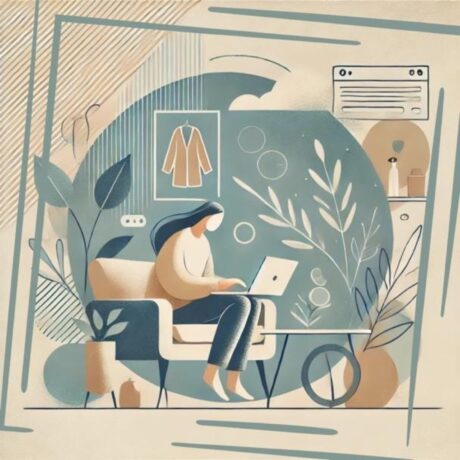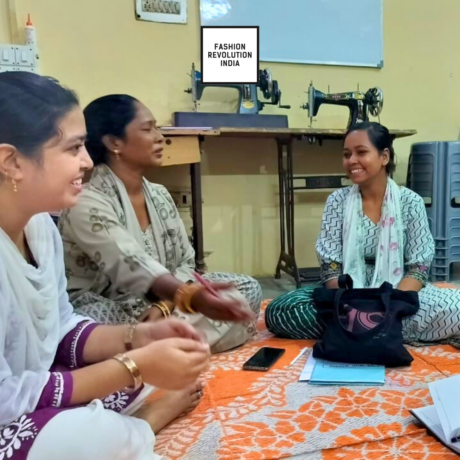Fashion an armor to save lives
The Corona Virus Disease 2019 (CoViD-19) pandemic has infected 3 million people and claimed 230 thousand lives worldwide. The lack of personal protective equipment (PPE) used by healthcare workers is one the challenges they face. The World Health Organization (WHO) has asked the different countries to manufacture more PPEs. In the Philippines healthcare workers are at a high risk. Most private hospitals use 10 to 15 PPE suits for one CoViD-19 patient in a week. While the Philippine General Hospital use 3 PPE suits also in a week. The PPEs can only be used for i a limited number of times.
People try to help by raising funds for more PPEs but manufacturers cannot cope up with the demand. The fashion community stepped up to help with the situation. These include the textile and garment workers, designers, artisans, and ordinary citizens who can sew PPE. The drawback is that many of them are not near medically standards and end up use by someone else.
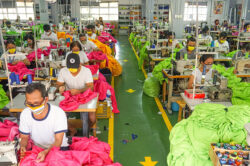
Volunteers sewing thousands of PPE suits, Photo courtesy of Abbey Balagbagan
Three students from Institute of Creative Entrepreneurship – Fashion and Design (ICE- FAD) have made PPEs based on the feedback they get from the healthcare workers to whom they donate it. Leilina Kate Yalung has made 300 washable face masks, Abbey Balagbagan has produce 20,000 face masks and 10,000 a two piece PPE suits since March 30 (as of April 21) will continue to do so until needed, and Erjohn dela Serna has made 982 pieces where he targets to create around 1,500. They have donated them to different barangays, Pasig City General Hospital, Child’s Hope Children’s Hospital, Cainta, Tarlac, Angeles, Pangasinan, Bacolod, Bulacan, and Navotas.
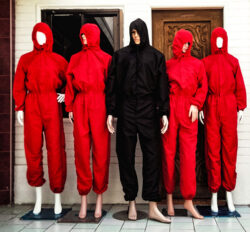
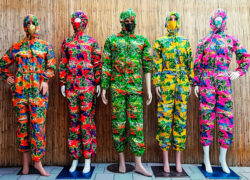
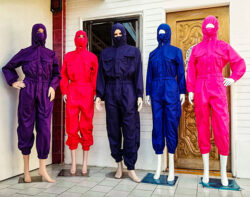
Erjohn dela Serna PPE suit designs
Kyra M. Mata has also donated 335 isolation (or hazmat) suits and 500 gowns. That went to the Southern Philippine Medical Center and other parts of Davao City with a project with Wear Forward called “Wear Together”. These hand-sewn suits are made from taffeta SBL (Silver Black Lining) the same material used for umbrellas. The patterns are cut to make sure they sew less and with a covering over the fly. They adjust the tension and make shorter stitches when sewing. Then do the water submersion test to check if they are air-tight. They sought advice from an Infectious Disease Specialist and help from Kendi Maristela, who teaches in the University of the Philippines (UP) Diliman College of Home Economics Clothing Tech Course, to make sure it is close to the medical-grade standard, which is a big challenge. She started the PPE design that is approved by the Department of Health (DOH). Another challenge supplies. They can only make as much as long the materials are available. They only use available stocks and rely on donations because they already spent enough money on their own.
The Manila Protective Gear Sewing Club was organized for the sole purpose of making these PPEs suits. They donate them to the Office of the Vice President (OVP) who has started aiding healthcare workers since the shortage through donation, collaboration, and calling for volunteers. It is through the OVP that they distribute the PPEs so there will be less hassle. According to Cynthia Diaz and Mich Dulce, of Manila Protective Gear Sewing Club, that there are no medical-grade fabrics or medical-grade production companies in the Philippines. In order to achieve the medical-grade standard, they consider every detail and the construction of the design that is reviewed and tested by a medical organization such as a hospital or an independent medical consultant. The design they have has been medically approved by the doctors behind the Open Source Covid19 Medical Supplies based in Berkeley, California.
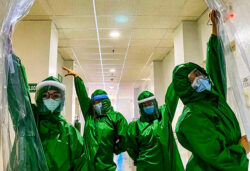
Healthcare workers trying out the donated PPE suits, Photo courtesy of Dr. Maria Almira Kiat
It is most rewarding to receive feedback from the different recipients of their donated PPE. Healthcare workers are overwhelmed that there are people like them willing to help in these times of crisis despite the restrictions imposed by the quarantine. They are also excited because of the different colors and designs of the PPE suit that is unusual to see. It also helps patients to recognize them which everyone is so grateful for. The advantage of these PPEs is that they are reusable and washable. According to Dr. Winston Pascual, who works in a public hospital with CoViD-19 patients, said that they are reusable and washable. They are cleaned by using bleach solution and bathe under the sun. Dr. Maria Almira Kiat, of Bataan General Hospital and Medical Center, said that as much as possible they autoclave besides washing. There are other areas where the healthcare workers are hesitant to autoclave them. The recipients of Kyra told her that even they have heat tested their PPE suits. Autoclave is one of the ways they can disinfect them properly, especially if used in direct contact with a CoViD-19 patient. Dr. Maria Almira said that they already have healthcare workers that got infected. That is why they categorize these PPE suits into two types A and B. The type A are inside wards that are in full gear or complete overall suits where they attend positive and suspected CoViD-19 patients. The other suits are considered type B where they use it outside the ward. These PPE suits are more comfortable compared to the ones procured from China by the DOH. Other countries have rejected these PPEs from China because they are defective.
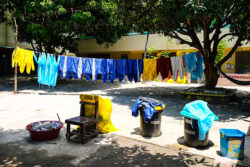
Donated DIY PPE suits are washed and sun dried, Photo courtesy of Kyra Mata
Despite the quarantine restriction people can still find a way to help in this time of crisis. It is people from the fashion community, from textile workers to designers, that can care for the needs of heroes who are the healthcare workers in the front line.
I like to end with a quote
“Fashion is the armor to survive the reality of everyday life.”
– Bill Cunningham.





